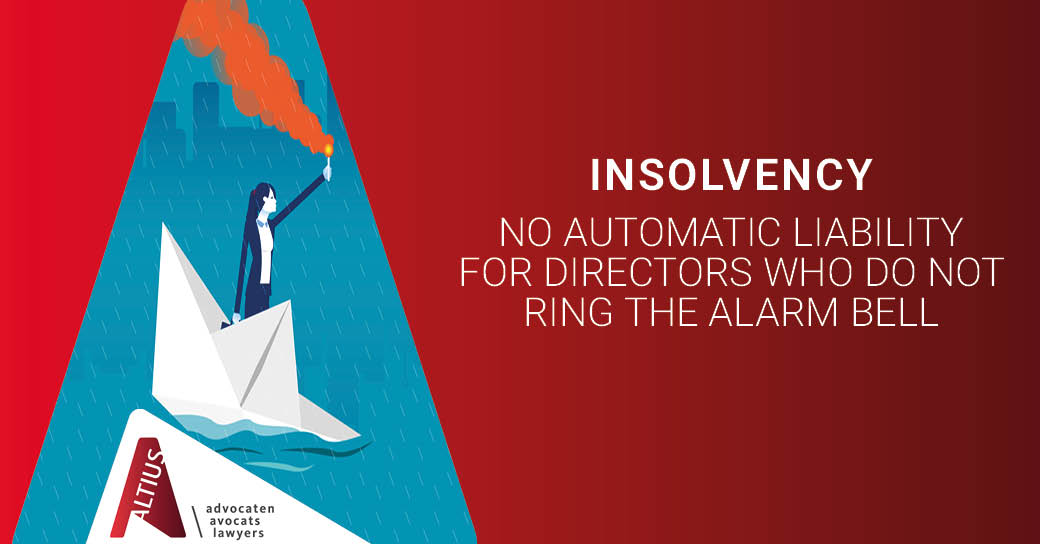New insolvency landscape on the horizon: more options for companies to reorganise and restructure

Belgium had accumulated a significant legislative backlog within insolvency law. The European Directive 2019/1023 on restructuring had to be transposed into national law by the member states by 17 July 2022 at the latest. The Belgian government did not submit a draft bill to this effect until 20 March 2023. This draft has since been voted into law and will enter into force on 1 September 2023.
Several amendments are being made to (among others) Book XX of the Belgian Economic Law. The main amendments are briefly discussed below.
1. Expanding the capabilities and powers of the Chambers for Companies in Difficulty (CCD)
In recent years, the CCD have already been granted new and expanded powers. This trend is continuing. In the future, the CCD will be able to intervene more actively, including by appointing a restructuring expert to facilitate the company’s restructuring. Moreover, the CCD may play a more active role in negotiations with creditors. To this end, the company in difficulty may request that the CCD summon some of its creditors to try to negotiate an amicable settlement.
2. Changes to the out-of-court amicable agreement
A company in difficulty may still conclude an amicable settlement with one or more of its creditors without the intervention of the court and without seeking protection from its creditors. However, for this arrangement to be more difficult to be challenged by a receiver in a subsequent bankruptcy, it will in future be required that this amicable arrangement is homologated by the President of the Commercial Court. If the President judges that the company has no chance of survival or the rights of third parties are violated, then the homologation will be refused.
3. New opportunities for judicial reorganisation
The new law provides for some new opportunities for corporate reorganisation. Reorganisation through an amicable agreement with some creditors or a collective agreement with all creditors will from now on exist in a “public” and “closed” version. The confidentiality of (new) closed versions should allow the company to reorganise its activities without the possible negative effects of publicity.
The (existing) procedure regarding collective agreement with creditors is now reserved for small and medium-sized enterprises. Large companies (e.g. more than 250 employees) have to follow a different collective agreement procedure. They must divide their creditors into several classes where, in principle, a majority of the creditors in each class must agree to the proposed reorganisation plan. Only in exceptional circumstances, if these majorities were not reached in each class, can the plan still be approved and imposed on all creditors of the company (a so-called ‘cross-class cramdown’).
4. Transfer of assets under court supervision
The transfer of assets under court supervision no longer refers to the “continuity” of the transferor’s activities, but will always end with bankruptcy or judicial dissolution. In this way, the legislator has tried to comply with the European Court of Justice’s rulings in the Plessers and Heiploeg cases (see, among others, here for an earlier blog on the subject).
5. Adjusting the duration of protection from creditors
In the past, the maximum protection period was 12 months, with the option of extending it for a further 6 months in the event of exceptional circumstances. If, subsequently, a transfer of assets under court supervision was envisaged, then a further 6 months’ additional protection could be granted. Accordingly, the (theoretical) maximum protection period was 24 months.
This period will be shortened. From now on, the total protection period cannot exceed 12 months. In the case of a court supervised transfer, an additional period of 4 months may be granted, thus moving to a maximum total of 16 months.
6. Introduction of prepacks
After some attempts to do so in the past, the Belgian legislator is introducing prepack proceedings (or closed preparation for bankruptcy). To this end, the company can request to be declared bankrupt and, prior to the bankruptcy declaration, already prepare the transfer of all or part of its assets and activities after bankruptcy. This is a closed procedure in which a “prospective bankruptcy trustee” (who will be appointed as trustee in the subsequent bankruptcy) should examine to what extent the objectives proposed by the debtor can be realised. The aim is, if possible, to already prepare the transfer of assets and activities prior to the bankruptcy so that, once the bankruptcy proceedings are opened, the transfer can be implemented quickly and smoothly.
7. More options for creditors
Creditors will be able to better assert their rights. For instance, a creditor who is disadvantaged by its counterpart’s protection or whose own continuity is threatened by it, can ask the court to lift the protection of the company in difficulty with regard to (only) this creditor. The court will only be able to grant this request to the extent that the debtor’s continuity is not threatened as a result.
8. Debt waiver
In the future, a bankrupt natural person will be automatically discharged of his/her residual debts without the need to submit a formal request to that effect (let alone within the former deadline of 6 months after the opening of the bankruptcy, which was a deadline that the Constitutional Court found to be unconstitutional). Only in cases of abuse or fraud can the public prosecutor, the bankruptcy trustee or other interested parties oppose the discharge, after which the court will have to decide.
9. Conclusion
From 1 September 2023, Belgian insolvency law will be different. Several adjustments that have in fact been years in the making will be introduced. More and better options will be offered to both struggling companies and creditors facing abuse or who would themselves get into trouble .
Question arises whether it will be sufficient. Moreover, on 7 December 2022, the European Commission published a new proposal for a directive, including on prepacks. Thus, additional changes to insolvency law will, more than likely, be needed in the coming years.
If you have any questions or would like any further information, please contact Bart Heynickx.
Written by
Recommended articles
New measures to address over-indebtedness and protect companies in difficulty
On 1 July 2024, the Act of 15 May 2024 on measures to address over-indebtedness and protect companies in difficulty was published in the Belgian Official State Gazette. The main amendments of the Act, as well as its entry into force, are briefly discussed below.
Read onHeiploeg’s impact on Belgian insolvency law
The European Court of Justice’s (“ECJ”) Plessers judgment seemed to cause a serious threat for the applicability of the Belgian reorganisation procedure by transfer under judicial supervision, and the right of the interested buyer of the debtor’s activities to choose which particular employees it would take over. But, in the end, it has turned out to be “much ado about nothing”.
Read onNo automatic liability for directors who do not ring the alarm bell
On 16 September 2021, the Antwerp Court of Appeal ruled on the liability of the directors of a company that did not respect the so-called ‘alarm bell procedure’.
Read on


